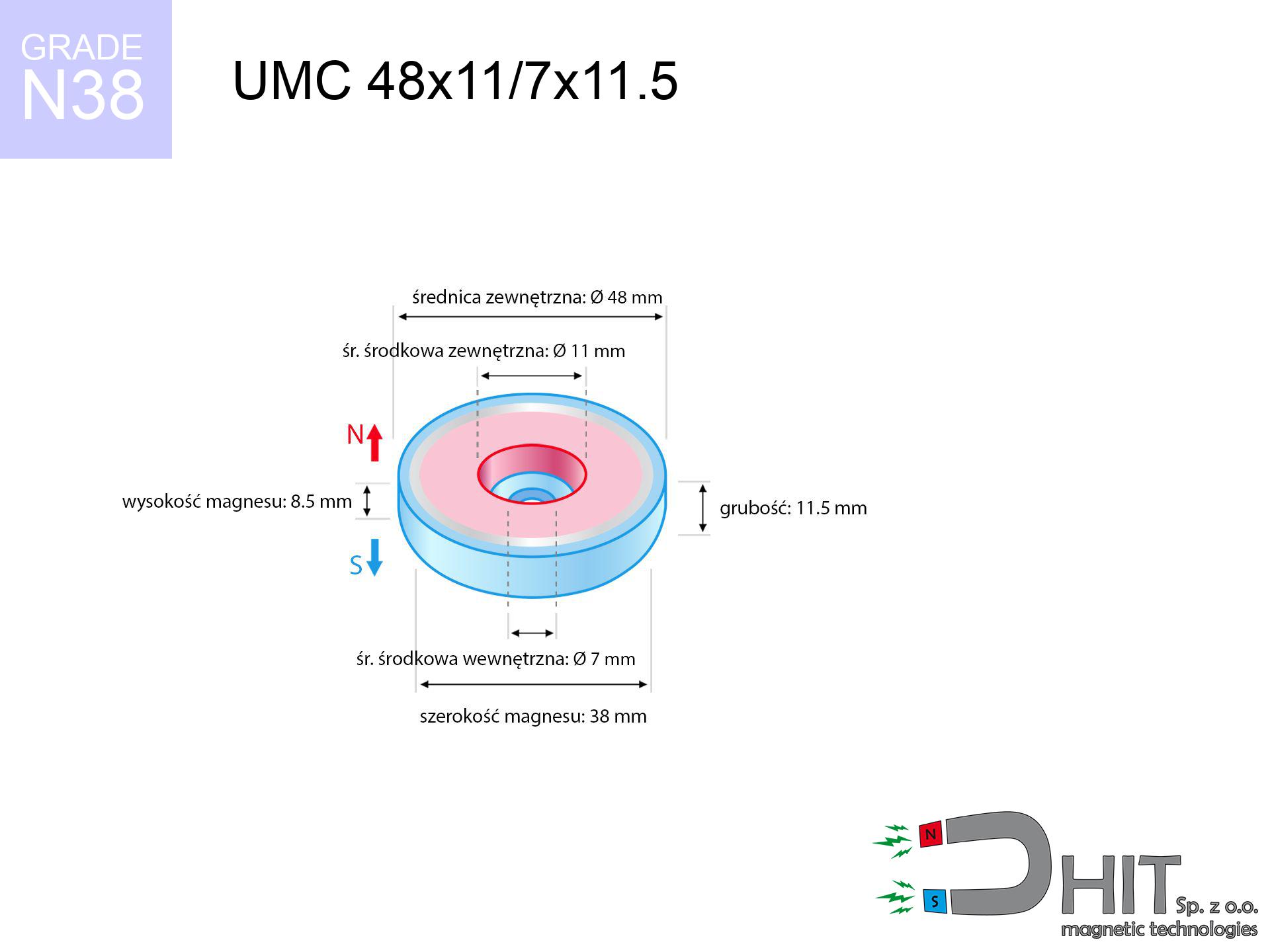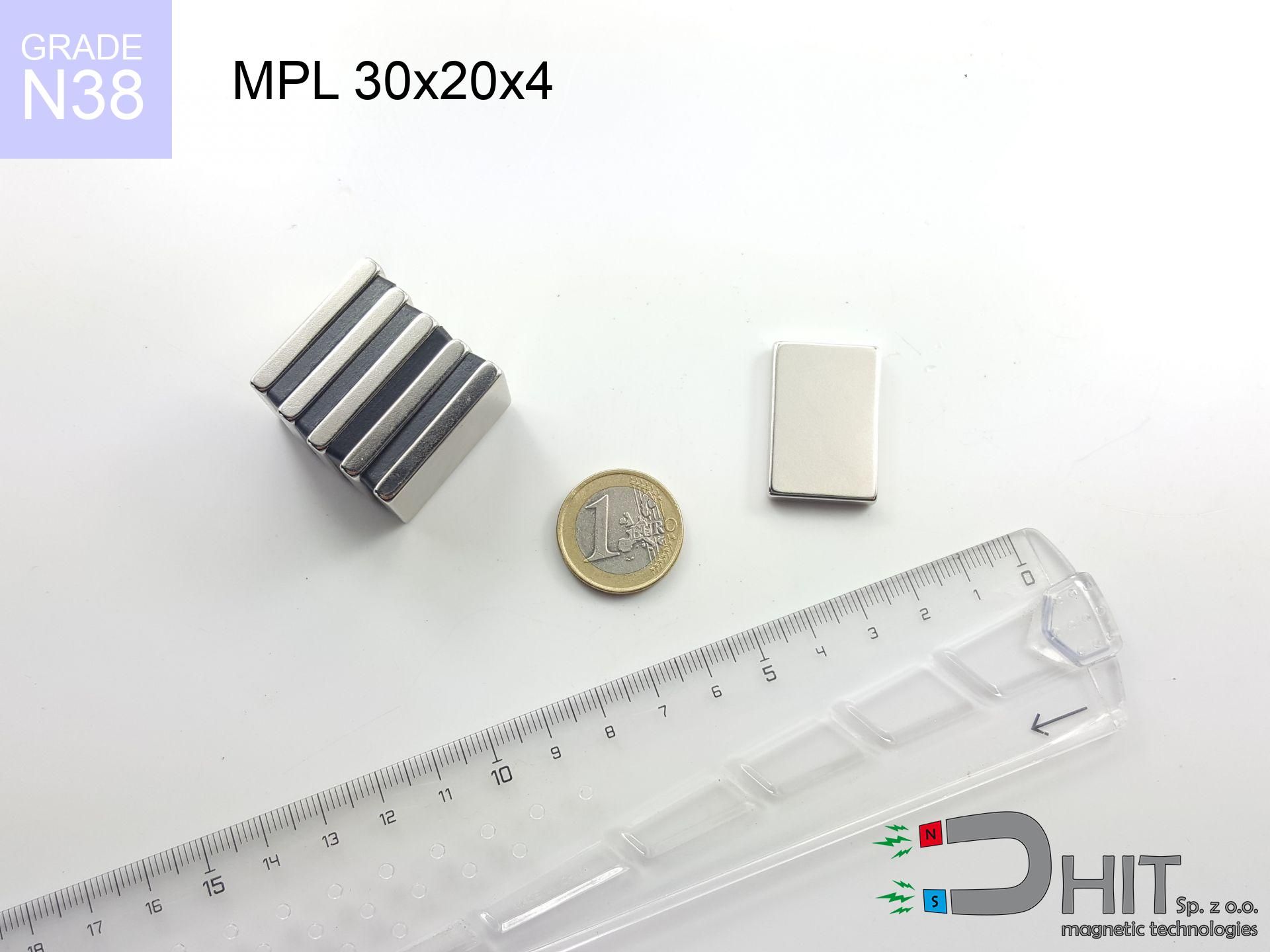UMC 48x11/7x11.5 / N38 - cylindrical magnetic holder
cylindrical magnetic holder
Catalog no 320412
GTIN/EAN: 5906301814689
Diameter
48 mm [±1 mm]
internal diameter Ø
11/7 mm [±1 mm]
Height
11.5 mm [±1 mm]
Weight
114 g
Load capacity
63.00 kg / 617.82 N
Coating
[NiCuNi] Nickel
45.10 ZŁ with VAT / pcs + price for transport
36.67 ZŁ net + 23% VAT / pcs
bulk discounts:
Need more?
Call us now
+48 888 99 98 98
alternatively send us a note using
contact form
the contact page.
Lifting power along with appearance of a neodymium magnet can be analyzed with our
magnetic calculator.
Orders placed before 14:00 will be shipped the same business day.
Technical data of the product - UMC 48x11/7x11.5 / N38 - cylindrical magnetic holder
Specification / characteristics - UMC 48x11/7x11.5 / N38 - cylindrical magnetic holder
| properties | values |
|---|---|
| Cat. no. | 320412 |
| GTIN/EAN | 5906301814689 |
| Production/Distribution | Dhit sp. z o.o. |
| Country of origin | Poland / China / Germany |
| Customs code | 85059029 |
| Diameter | 48 mm [±1 mm] |
| internal diameter Ø | 11/7 mm [±1 mm] |
| Height | 11.5 mm [±1 mm] |
| Weight | 114 g |
| Load capacity ~ ? | 63.00 kg / 617.82 N |
| Coating | [NiCuNi] Nickel |
| Manufacturing Tolerance | ±1 mm |
Magnetic properties of material N38
| properties | values | units |
|---|---|---|
| remenance Br [min. - max.] ? | 12.2-12.6 | kGs |
| remenance Br [min. - max.] ? | 1220-1260 | mT |
| coercivity bHc ? | 10.8-11.5 | kOe |
| coercivity bHc ? | 860-915 | kA/m |
| actual internal force iHc | ≥ 12 | kOe |
| actual internal force iHc | ≥ 955 | kA/m |
| energy density [min. - max.] ? | 36-38 | BH max MGOe |
| energy density [min. - max.] ? | 287-303 | BH max KJ/m |
| max. temperature ? | ≤ 80 | °C |
Physical properties of sintered neodymium magnets Nd2Fe14B at 20°C
| properties | values | units |
|---|---|---|
| Vickers hardness | ≥550 | Hv |
| Density | ≥7.4 | g/cm3 |
| Curie Temperature TC | 312 - 380 | °C |
| Curie Temperature TF | 593 - 716 | °F |
| Specific resistance | 150 | μΩ⋅cm |
| Bending strength | 250 | MPa |
| Compressive strength | 1000~1100 | MPa |
| Thermal expansion parallel (∥) to orientation (M) | (3-4) x 10-6 | °C-1 |
| Thermal expansion perpendicular (⊥) to orientation (M) | -(1-3) x 10-6 | °C-1 |
| Young's modulus | 1.7 x 104 | kg/mm² |
Chemical composition
| iron (Fe) | 64% – 68% |
| neodymium (Nd) | 29% – 32% |
| boron (B) | 1.1% – 1.2% |
| dysprosium (Dy) | 0.5% – 2.0% |
| coating (Ni-Cu-Ni) | < 0.05% |
Ecology and recycling (GPSR)
| recyclability (EoL) | 100% |
| recycled raw materials | ~10% (pre-cons) |
| carbon footprint | low / zredukowany |
| waste code (EWC) | 16 02 16 |
Check out also proposals
Strengths as well as weaknesses of rare earth magnets.
Pros
- They virtually do not lose strength, because even after ten years the performance loss is only ~1% (according to literature),
- They are extremely resistant to demagnetization induced by external field influence,
- A magnet with a smooth nickel surface has better aesthetics,
- Magnetic induction on the top side of the magnet is exceptional,
- Thanks to resistance to high temperature, they are able to function (depending on the shape) even at temperatures up to 230°C and higher...
- Thanks to freedom in constructing and the ability to customize to client solutions,
- Fundamental importance in future technologies – they find application in data components, electric motors, advanced medical instruments, as well as industrial machines.
- Relatively small size with high pulling force – neodymium magnets offer impressive pulling force in tiny dimensions, which makes them useful in miniature devices
Disadvantages
- They are fragile upon too strong impacts. To avoid cracks, it is worth protecting magnets in a protective case. Such protection not only protects the magnet but also increases its resistance to damage
- Neodymium magnets lose their power under the influence of heating. As soon as 80°C is exceeded, many of them start losing their power. Therefore, we recommend our special magnets marked [AH], which maintain stability even at temperatures up to 230°C
- When exposed to humidity, magnets usually rust. For applications outside, it is recommended to use protective magnets, such as those in rubber or plastics, which secure oxidation and corrosion.
- Due to limitations in producing nuts and complicated shapes in magnets, we recommend using cover - magnetic holder.
- Possible danger to health – tiny shards of magnets pose a threat, if swallowed, which is particularly important in the context of child health protection. Furthermore, small elements of these magnets can be problematic in diagnostics medical in case of swallowing.
- With large orders the cost of neodymium magnets is a challenge,
Lifting parameters
Maximum lifting capacity of the magnet – what affects it?
- using a sheet made of high-permeability steel, acting as a magnetic yoke
- whose thickness is min. 10 mm
- characterized by smoothness
- without any insulating layer between the magnet and steel
- during pulling in a direction perpendicular to the plane
- at room temperature
Lifting capacity in real conditions – factors
- Space between magnet and steel – every millimeter of separation (caused e.g. by varnish or unevenness) significantly weakens the pulling force, often by half at just 0.5 mm.
- Direction of force – maximum parameter is available only during pulling at a 90° angle. The shear force of the magnet along the plate is standardly several times smaller (approx. 1/5 of the lifting capacity).
- Substrate thickness – for full efficiency, the steel must be adequately massive. Thin sheet restricts the attraction force (the magnet "punches through" it).
- Metal type – not every steel attracts identically. High carbon content worsen the interaction with the magnet.
- Surface structure – the smoother and more polished the surface, the larger the contact zone and stronger the hold. Roughness creates an air distance.
- Thermal factor – hot environment weakens magnetic field. Exceeding the limit temperature can permanently demagnetize the magnet.
Holding force was measured on a smooth steel plate of 20 mm thickness, when the force acted perpendicularly, however under parallel forces the load capacity is reduced by as much as fivefold. In addition, even a small distance between the magnet’s surface and the plate decreases the lifting capacity.
H&S for magnets
Finger safety
Danger of trauma: The attraction force is so great that it can result in hematomas, crushing, and even bone fractures. Use thick gloves.
Demagnetization risk
Watch the temperature. Exposing the magnet above 80 degrees Celsius will destroy its magnetic structure and pulling force.
Dust explosion hazard
Drilling and cutting of neodymium magnets carries a risk of fire risk. Neodymium dust oxidizes rapidly with oxygen and is difficult to extinguish.
Risk of cracking
Despite metallic appearance, the material is delicate and not impact-resistant. Avoid impacts, as the magnet may crumble into hazardous fragments.
Electronic devices
Equipment safety: Neodymium magnets can ruin data carriers and sensitive devices (heart implants, medical aids, mechanical watches).
Life threat
People with a ICD have to keep an large gap from magnets. The magnetism can interfere with the operation of the implant.
Threat to navigation
Remember: neodymium magnets generate a field that disrupts sensitive sensors. Maintain a safe distance from your phone, tablet, and GPS.
Immense force
Be careful. Rare earth magnets act from a long distance and snap with huge force, often quicker than you can react.
Sensitization to coating
It is widely known that nickel (standard magnet coating) is a common allergen. If you have an allergy, prevent direct skin contact and opt for versions in plastic housing.
Adults only
Strictly keep magnets out of reach of children. Ingestion danger is high, and the consequences of magnets clamping inside the body are life-threatening.






![UMGGW 34x8 [M4] GW / N38 - magnetic holder rubber internal thread UMGGW 34x8 [M4] GW / N38 - magnetic holder rubber internal thread](https://cdn3.dhit.pl/graphics/products/umg-34x8-m4-gw-kek.jpg)


